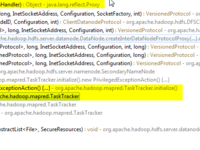Hadoop所有的跨节点的通信都是通过RPC来通信的, RPC通信是需要创建Stub,一个好的RPC需要通过良好的设计确保了对上层调用的透明性. 我们下面就通过Hadoop里面最常用的心跳(JobTrack和TaskTracker)来
研究一下Hadoop的R
PC机制.
心跳函数的调用在方法:TaskTracker.transmitHeartBeat();在此方法中会调用下面的代码段.这个方法实际就不一个本地调用,jobClient实际上就是一个动态代理生成的对象,这个对象已经包括了RPC的Stub.
class="java"> //
// Xmit the heartbeat
//
HeartbeatResponse heartbeatResponse = jobClient.heartbeat(status,
justStarted,
justInited,
askForNewTask,
heartbeatResponseId);
?
也就是 TaskTracker 通过 jobClient(InterTrackerProtocol) 来调用 JobTracker, 而JobClient实现了
接口 jobClient(InterTrackerProtocol).
这是一个典型的Java动态代理的应用场景. 同时RPC调用需要跨越网络,现在我们就来看看Hadoop是如何透明的创建一个jobClient实例.
?
//这个是对jobClient的定义
InterTrackerProtocol jobClient;
//下面可以看出jobClient和JobTracker 实现了相同的接口
interface InterTrackerProtocol extends VersionedProtocol;
public class JobTracker implements MRConstants, InterTrackerProtocol,
JobSubmissionProtocol, TaskTrackerManager, RefreshUserMappingsProtocol,
RefreshAuthorizationPolicyProtocol, AdminOperationsProtocol,
JobTrackerMXBean {
??
//下面是jobClient初始化的代码
this.jobClient = (InterTrackerProtocol)
UserGroupInformation.getLoginUser().doAs(
new PrivilegedExceptionAction<Object>() {
public Object run() throws IOException {
return RPC.waitForProxy(InterTrackerProtocol.class,
InterTrackerProtocol.versionID,
jobTrackAddr, fConf);
}
});
?
下图就是来自于对TaskTracker.initialize()的跟踪, 从该调用栈就可以看出TaskTracker是如何通过动态代理创建出一个RPC 客户端, 却不需要调用者提供任何信息.

2点注意:
1)RPC客户端如何得到端口号,服务器地址?
下面的代码已经添加了
注释,可以看到,RPC客户端如何得到服务器地址,端口号,并生成stub,形成动态代理.
//下面是Java动态代理调用处, RPC.getProxy()
//参数addr已经封装了端口号,和地址, 这个地址就是TaskTracker里面的成员变量jobTrackAddr一级一级传递下来,传递路径就是上图所示.
VersionedProtocol proxy =
(VersionedProtocol) Proxy.newProxyInstance(
protocol.getClassLoader(), new Class[] { protocol },
new Invoker(protocol, addr, ticket, conf, factory, rpcTimeout));
//最后一个参数Invoker是RPC的一个内部类,它实现了接口InvocationHandler,下面是他的构造函数
private static class Invoker implements InvocationHandler {
private Client.ConnectionId remoteId;
private Client client;
private boolean isClosed = false;
//在构造函数中,客户端和服务器建立连接
public Invoker(Class<? extends VersionedProtocol> protocol,
InetSocketAddress address, UserGroupInformation ticket,
Configuration conf, SocketFactory factory,
int rpcTimeout) throws IOException {
this.remoteId = Client.ConnectionId.getConnectionId(address, protocol,
ticket, rpcTimeout, conf);
this.client = CLIENTS.getClient(conf, factory);
}
//调用时,直接把准备好的参数通过连接发给服务器并同步获取返回值
public Object invoke(Object proxy, Method method, Object[] args)
throws Throwable {
final boolean logDebug = LOG.isDebugEnabled();
long startTime = 0;
if (logDebug) {
startTime = System.currentTimeMillis();
}
ObjectWritable value = (ObjectWritable)
client.call(new Invocation(method, args), remoteId);
if (logDebug) {
long callTime = System.currentTimeMillis() - startTime;
LOG.debug("Call: " + method.getName() + " " + callTime);
}
return value.get();
}
/* close the IPC client that's responsible for this invoker's RPCs */
synchronized private void close() {
if (!isClosed) {
isClosed = true;
CLIENTS.stopClient(client);
}
}
}
??
2)服务器采用的是NIO,客户端采用的是BIO
客户端的调用就是BIO,不是NIO.调用方式在上文已经通过jobClient.heartbeat()举例做了相应的分析.
Listener将以独立的
线程启动,并以
异步(NIO)方式
监听指定端口.下面的代码已经添加了注释,可以看出Listener如何监听连接,并
开启对应的Reader来异步处理对应的数据.
Listener服务开启于JobTracker,因为要面对大量的TaskTracker连接,所以使用Server使用NIO来处理,这也是NIO典型的应用场景.
//Listener是 org.apache.hadoop.ipc.Server的内部类(实际上是Server的父类的内部类)
//下面是Listener唯一的构造函数
public Listener() throws IOException {
address = new InetSocketAddress(bindAddress, port);
// Create a new server socket and set to non blocking mode
acceptChannel = ServerSocketChannel.open();
acceptChannel.configureBlocking(false);
// Bind the server socket to the local host and port
bind(acceptChannel.socket(), address, backlogLength);
port = acceptChannel.socket().getLocalPort(); //Could be an ephemeral port
// create a selector;
selector= Selector.open();
readers = new Reader[readThreads];
readPool = Executors.newFixedThreadPool(readThreads);
for (int i = 0; i < readThreads; i++) {
Selector readSelector = Selector.open();
Reader reader = new Reader(readSelector);
readers[i] = reader;
//并不会真正的开始处理数据,Reader在没有被Linster初始化之前,run()会一直处于自旋等待
readPool.execute(reader);
}
// Register accepts on the server socket with the selector.
//绑定selector和连接初始化事件,连接初始化时,在doAccept里面先对Reader初始化,然后Reader开始处理数据.
acceptChannel.register(selector, SelectionKey.OP_ACCEPT);
this.setName("IPC Server listener on " + port);
this.setDaemon(true);
}
?
?
?参考:http://blog.csdn.net/jiangwei0910410003/article/details/21155911

- 大小: 45.1 KB
 2点注意:
1)RPC客户端如何得到端口号,服务器地址?
下面的代码已经添加了注释,可以看到,RPC客户端如何得到服务器地址,端口号,并生成stub,形成动态代理.
2点注意:
1)RPC客户端如何得到端口号,服务器地址?
下面的代码已经添加了注释,可以看到,RPC客户端如何得到服务器地址,端口号,并生成stub,形成动态代理.